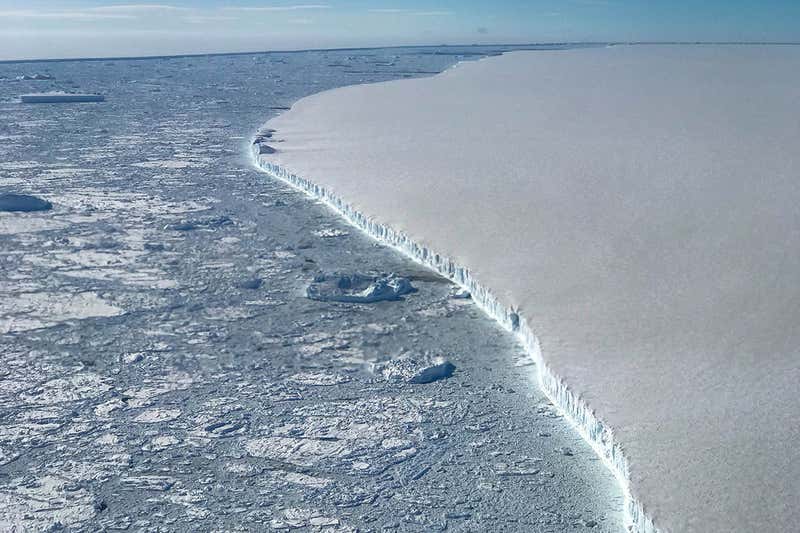Over a third of Antarctic ice shelf could collapse as climate change warms the Earth

Over a third of the Antarctic ice shelf is at risk of collapsing as Earth continues to warm.
In a new study, scientists at the University of Reading have found that as climate change continues, if Earth's global temperature rises to 7.2 degrees Fahrenheit (4 degrees Celsius) above pre-industrial levels, about 193,000 square miles (500,000 square kilometers) of the Antarctic ice shelves could collapse into the sea. Ice shelves are permanent floating slabs of ice attached to coastline, and the collapse of these shelves could significantly raise global sea levels, the researchers suggest.
"Ice shelves are important buffers preventing glaciers on land from flowing freely into the ocean and contributing to sea level rise. When they collapse, it's like a giant cork being removed from a bottle, allowing unimaginable amounts of water from glaciers to pour into the sea," lead study author Ella Gilbert, a research scientist in the University of Reading's Department of Meteorology, said in a statement.
Related: 2020 ties record for hottest year ever, NASA analysis shows
Every summer in Antarctica, ice on the surface of the ice shelf melts and that water travels into the snow below where it refreezes. But in years with more melting ice than snowfall, that water ends up pooling on the ice shelf's surface and falls into cracks in the ice, melting and growing those cracks until the ice shelf breaks off into the ocean. This exact thing happened with the Larsen B ice shelf in 2002 and in this study researchers identify ice shelf Larsen C as at particular risk for collapse in warmer temperatures.
In this study, researchers used high-resolution regional climate modeling technology to predict how melting ice and water runoff will affect ice shelf stability over time and at different global temperatures. They modeled ice shelf vulnerability at global temperatures 2.7 degrees F (1.5 degreesC), 3.6 degrees F (2 degrees C) and 7.2 degrees F (4 degrees C) above pre-industrial levels, three scenarios that are all possible within this century, according to the statement.
"We know that when melted ice accumulates on the surface of ice shelves, it can make them fracture and collapse spectacularly. Previous research has given us the bigger picture in terms of predicting Antarctic ice shelf decline, but our new study uses the latest modelling techniques to fill in the finer detail and provide more precise projections," Gilbert said.
Get the Space.com Newsletter
Breaking space news, the latest updates on rocket launches, skywatching events and more!
They found that, at 7.2 degrees F (4 degrees C) above pre-industrial global temperatures, 34%of all Antarctic ice shelves (including 67%of the ice shelf area on the Antarctic Peninsula)
"The findings highlight the importance of limiting global temperature increases as set out in the Paris Agreement if we are to avoid the worst consequences of climate change, including sea level rise," Gilbert said.
The Paris Agreement is an international treaty that was signed in 2016, made within the United Nations Framework Convention on Climate Change. Under the agreement, nations have pledged to work to limit global temperature increase to 3.6 degrees F (2 degrees C), or preferably 2.7 degrees F (1.5 degrees C), above pre-industrial levels.
Related: Earth is hotter than ever — So what happens next?
Scientists have been worried about the continued effects of global warming on floating ice shelves for some time.
"The floating ice shelves around the coast of Antarctica are of particular concern," Paul Cutler, a program director for National Science Foundation's Antarctic Sciences Division, said during a live webinar Thursday (April 8). "They interface with the ocean which is changing, and they hold back the flow of the inland ice as it moves towards the ocean. So if you lose the integrity of those ice shelves, you release more inland ice to the ocean, and you cause even more sea level rise."
Rising sea levels can have many dangerous effects including extreme coastal flooding, destructive erosion and more.
Additionally, "with the loss of the glaciers, you actually lose their gravitational pull," Cutler said. "So when you lose West Antarctica, you lose its gravitational pull on the United States. And actually, part of the sea level rise we see in the U.S. is related to the loss of ices by that indirect gravity effect as well."
"Limiting warming will not just be good for Antarctica — preserving ice shelves means less global sea level rise, and that’s good for us all," Gilbert said.
This work was published April 8 in the journal Geophysical Research Letters.
Email Chelsea Gohd at cgohd@space.com or follow her on Twitter @chelsea_gohd. Follow us on Twitter @Spacedotcom and on Facebook.
Join our Space Forums to keep talking space on the latest missions, night sky and more! And if you have a news tip, correction or comment, let us know at: community@space.com.

Chelsea “Foxanne” Gohd joined Space.com in 2018 and is now a Senior Writer, writing about everything from climate change to planetary science and human spaceflight in both articles and on-camera in videos. With a degree in Public Health and biological sciences, Chelsea has written and worked for institutions including the American Museum of Natural History, Scientific American, Discover Magazine Blog, Astronomy Magazine and Live Science. When not writing, editing or filming something space-y, Chelsea "Foxanne" Gohd is writing music and performing as Foxanne, even launching a song to space in 2021 with Inspiration4. You can follow her on Twitter @chelsea_gohd and @foxannemusic.









